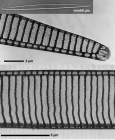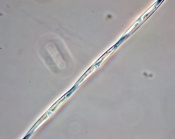
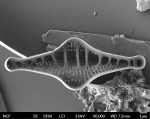
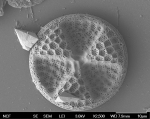
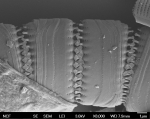

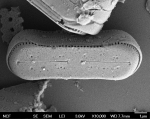
DiatomBase
DiatomBase taxon details
Pseudo-nitzschia seriata (Cleve) H.Peragallo, 1899
149152 (urn:lsid:marinespecies.org:taxname:149152)
accepted
Species
Nitzschia seratia Cleve · unaccepted (misspelling)
Nitzschia seriata Cleve, 1883 · unaccepted (Synonym)
Pseudo-nitzschia seriata f. seriata · unaccepted (same as nominate)
- Forma Pseudo-nitzschia seriata f. seriata accepted as Pseudo-nitzschia seriata (Cleve) H.Peragallo, 1899 (same as nominate)
- Variety Pseudo-nitzschia seriata var. fraudulenta (Cleve) H.Peragallo, 1897 accepted as Pseudo-nitzschia fraudulenta (Cleve) Hasle, 1993
- Forma Pseudo-nitzschia seriata f. obtusa (Hasle) Hasle, 1993 accepted as Nitzschia seriata f. obtusa Hasle, 1965 (uncertain > unassessed)
marine, terrestrial
recent only
Cleve P.T. 1883: Vega-ekspeditionens Vetenskapliga Iakttagelser 3: 455-517 [details]
Type locality contained in Tindingen
type locality contained in Tindingen [details]
Distribution P. seriata is a cold-water species. Previously known only from the Northern Hemisphere in the Atlantic, but recently also...
Distribution P. seriata is a cold-water species. Previously known only from the Northern Hemisphere in the Atlantic, but recently also from the Northern Pacific. Recently, it was reported from the Southern cold Pacific. Due to morphological variability of P. seriata and related species, this needs to be confirmed either by molecular data. [details]
Kociolek, J.P.; Blanco, S.; Coste, M.; Ector, L.; Liu, Y.; Karthick, B.; Kulikovskiy, M.; Lundholm, N.; Ludwig, T.; Potapova, M.; Rimet, F.; Sabbe, K.; Sala, S.; Sar, E.; Taylor, J.; Van de Vijver, B.; Wetzel, C.E.; Williams, D.M.; Witkowski, A.; Witkowski, J. (2025). DiatomBase. Pseudo-nitzschia seriata (Cleve) H.Peragallo, 1899. Accessed at: https://diatombase.org/aphia.php?p=taxdetails&id=149152 on 2025-09-11
Date
action
by
2005-03-30 08:52:46Z
created
db_admin
original description
Cleve P.T. 1883: Vega-ekspeditionens Vetenskapliga Iakttagelser 3: 455-517 [details]
context source (Deepsea) Intergovernmental Oceanographic Commission (IOC) of UNESCO. The Ocean Biogeographic Information System (OBIS), available online at http://www.iobis.org/ [details]
context source (HKRMS) Lam CWY. & Ho KC. (1988). Phytoplankton characteristics of Tolo Harbour. In: Morton B, editor. Asian Marine Biology 6. pp 5-18. Hong Kong University Press, Hong Kong. [details]
context source (Schelde) MWTL biological monitoring network Westerschelde: Phytoplankton [MWTL biologisch monitoring netwerk Westerschelde: Fytoplankton] [details]
basis of record M'harzi, A. (1999). Phytoplankton community structuring in some areas of the North Sea. PhD Thesis. Vrije Universiteit Brussel: Brussel, Belgium. 221 pp. (look up in IMIS) [details]
additional source Tomas, C.R. (Ed.). (1997). Identifying marine phytoplankton. Academic Press: San Diego, CA [etc.] (USA). ISBN 0-12-693018-X. XV, 858 pp., available online at http://www.sciencedirect.com/science/book/9780126930184 [details]
additional source Lundholm N., Skov, J., Pocklington R. & Moestrup Ø. 1994. Domoic acid, the amino acid responsible for amnesic shellfish poisoning, now in <i>Pseudo-nitzschia seriata</i> (Bacillariophyceae) in Europe. Phycologia 33: 475-478. [details]
additional source Krayesky, D. M.; Meave, D. C.; Zamudio, E.; Norris, E.; Fredericq, S.; Tunnell, J. (2009). Diatoms (Bacillariophyta) of the Gulf of Mexico. <em>Gulf of Mexico origin, waters, and biota.</em> 1: 155-186. [details] Available for editors [request]
[request]
additional source Moestrup, Ø., Akselman, R., Cronberg, G., Elbraechter, M., Fraga, S., Halim, Y., Hansen, G., Hoppenrath, M., Larsen, J., Lundholm, N., Nguyen, L. N., Zingone, A. (Eds) (2009 onwards). IOC-UNESCO Taxonomic Reference List of Harmful Micro Algae., available online at http://www.marinespecies.org/HAB [details]
additional source Liu, J.Y. [Ruiyu] (ed.). (2008). Checklist of marine biota of China seas. <em>China Science Press.</em> 1267 pp. (look up in IMIS) [details] Available for editors [request]
[request]
additional source Harper, M.A.; Cassie Cooper, V.; Chang, F.H.; Nelson, W.A.; Broady, P.A. (2012). Phylum Ochrophyta: brown and golden-brown algae, diatoms, silicoflagellates, and kin, in: Gordon, D.P. (Ed.) (2012). New Zealand inventory of biodiversity: 3. Kingdoms Bacteria, Protozoa, Chromista, Plantae, Fungi. pp. 114-163. [details]
redescription Hasle, G.R. (1965). Nitzschia and Fragilariopsis species studied in the light and electron microscope. II. The group Pseudonitzschia. Skrifter utgitt av Det Norske Videnskaps-Akademi i Oslo, Matematisk-naturvidenskapelig klasse, Ny Ser.,, 18: 45 pp., 17 pls [details]
new combination reference Peragallo H. & Peragallo M. 1897-1908. Diatomées de France (Ed. by M.J. Tempère). Micrographe-Editeur, Grez-sur-Loing, 2, 492 pp. [details]
context source (Deepsea) Intergovernmental Oceanographic Commission (IOC) of UNESCO. The Ocean Biogeographic Information System (OBIS), available online at http://www.iobis.org/ [details]
context source (HKRMS) Lam CWY. & Ho KC. (1988). Phytoplankton characteristics of Tolo Harbour. In: Morton B, editor. Asian Marine Biology 6. pp 5-18. Hong Kong University Press, Hong Kong. [details]
context source (Schelde) MWTL biological monitoring network Westerschelde: Phytoplankton [MWTL biologisch monitoring netwerk Westerschelde: Fytoplankton] [details]
basis of record M'harzi, A. (1999). Phytoplankton community structuring in some areas of the North Sea. PhD Thesis. Vrije Universiteit Brussel: Brussel, Belgium. 221 pp. (look up in IMIS) [details]
additional source Tomas, C.R. (Ed.). (1997). Identifying marine phytoplankton. Academic Press: San Diego, CA [etc.] (USA). ISBN 0-12-693018-X. XV, 858 pp., available online at http://www.sciencedirect.com/science/book/9780126930184 [details]
additional source Lundholm N., Skov, J., Pocklington R. & Moestrup Ø. 1994. Domoic acid, the amino acid responsible for amnesic shellfish poisoning, now in <i>Pseudo-nitzschia seriata</i> (Bacillariophyceae) in Europe. Phycologia 33: 475-478. [details]
additional source Krayesky, D. M.; Meave, D. C.; Zamudio, E.; Norris, E.; Fredericq, S.; Tunnell, J. (2009). Diatoms (Bacillariophyta) of the Gulf of Mexico. <em>Gulf of Mexico origin, waters, and biota.</em> 1: 155-186. [details] Available for editors
additional source Moestrup, Ø., Akselman, R., Cronberg, G., Elbraechter, M., Fraga, S., Halim, Y., Hansen, G., Hoppenrath, M., Larsen, J., Lundholm, N., Nguyen, L. N., Zingone, A. (Eds) (2009 onwards). IOC-UNESCO Taxonomic Reference List of Harmful Micro Algae., available online at http://www.marinespecies.org/HAB [details]
additional source Liu, J.Y. [Ruiyu] (ed.). (2008). Checklist of marine biota of China seas. <em>China Science Press.</em> 1267 pp. (look up in IMIS) [details] Available for editors
additional source Harper, M.A.; Cassie Cooper, V.; Chang, F.H.; Nelson, W.A.; Broady, P.A. (2012). Phylum Ochrophyta: brown and golden-brown algae, diatoms, silicoflagellates, and kin, in: Gordon, D.P. (Ed.) (2012). New Zealand inventory of biodiversity: 3. Kingdoms Bacteria, Protozoa, Chromista, Plantae, Fungi. pp. 114-163. [details]
redescription Hasle, G.R. (1965). Nitzschia and Fragilariopsis species studied in the light and electron microscope. II. The group Pseudonitzschia. Skrifter utgitt av Det Norske Videnskaps-Akademi i Oslo, Matematisk-naturvidenskapelig klasse, Ny Ser.,, 18: 45 pp., 17 pls [details]
new combination reference Peragallo H. & Peragallo M. 1897-1908. Diatomées de France (Ed. by M.J. Tempère). Micrographe-Editeur, Grez-sur-Loing, 2, 492 pp. [details]
 Present
Present  Inaccurate
Inaccurate  Introduced: alien
Introduced: alien  Containing type locality
Containing type locality
From regional or thematic species database
Distribution P. seriata is a cold-water species. Previously known only from the Northern Hemisphere in the Atlantic, but recently also from the Northern Pacific. Recently, it was reported from the Southern cold Pacific. Due to morphological variability of P. seriata and related species, this needs to be confirmed either by molecular data. [details]Harmful effect P. seriata has been implicated in toxic episodes in the field in Europe (Denmark, Ireland, Scotland) and Canada. It has caused DA in sea scallops and molluscan shellfish in Canada, in blue mussels in Denmark, and associated with DA in king scallops in Scotland.
DA levels above the regularory limit (20µm g-1) has been found at concentrations of 50-62,000 cells L-1 in Canada and Denmark. [details]
Identification requires electron microscopy.
The main characteristics of P. seriata are the asymmetric valve and the 4 rows of poroids (2 outer rows of larger poroids and 2 inner rows of smaller poroids).
P. seriata is phylogenetically and morphologically closely related to P. obtusa and P. australis, two other species with asymmetric valves. The main differences are the number of poroid rows in the striae, poroid density, and valve width. However, in P. seriata number of poroid rows and poroid density has been found to decrease with increasing temperature, making identification difficult.
P. seriata: (2)-4 rows - 6-9 poroids/µm - 4.6-8.0µm
P. obtusa: 2 rows - 6-8 poroids/µm - 2.9-5.0µm
P. australis: 2 rows - 4-5 poroids/µm - 6.5-8.0µm
Verified sequences of ITS rDNA (ITS1, 5.8S, ITS2) are:
P. seriata (DQ062663); P. obtusa (DQ062667); P. australis (DQ062661)
[details]
Toxicology Strains of the species have been confirmed to produce domoic acid (DA) in cultures from the cold temperate Northern Atlantic and Northern Arctic. Some strains have in addition to DA been shown to produce the two isomers isodomoic acid A (IA) and isodomoic acid B (IB) (Hansen et al. 2011). DA have so far been found to make up the largest proportion of the toxins. DA production in cultures have been found to vary from 0.16 pg cell-1 to 33.6 pg cell-1.
[details]
To Barcode of Life
To Biodiversity Heritage Library (2 publications)
To Biodiversity Heritage Library (97 publications) (from synonym Nitzschia seriata Cleve, 1883)
To Dyntaxa
To European Nucleotide Archive, ENA (Pseudo-nitzschia seriata)
To GenBank (31 nucleotides; 1 proteins)
To PESI
To PESI (from synonym Nitzschia seratia Cleve)
To PESI (from synonym Nitzschia seriata Cleve, 1883)
To PESI (from synonym Pseudo-nitzschia seriata f. seriata)
To ITIS
To Biodiversity Heritage Library (2 publications)
To Biodiversity Heritage Library (97 publications) (from synonym Nitzschia seriata Cleve, 1883)
To Dyntaxa
To European Nucleotide Archive, ENA (Pseudo-nitzschia seriata)
To GenBank (31 nucleotides; 1 proteins)
To PESI
To PESI (from synonym Nitzschia seratia Cleve)
To PESI (from synonym Nitzschia seriata Cleve, 1883)
To PESI (from synonym Pseudo-nitzschia seriata f. seriata)
To ITIS
